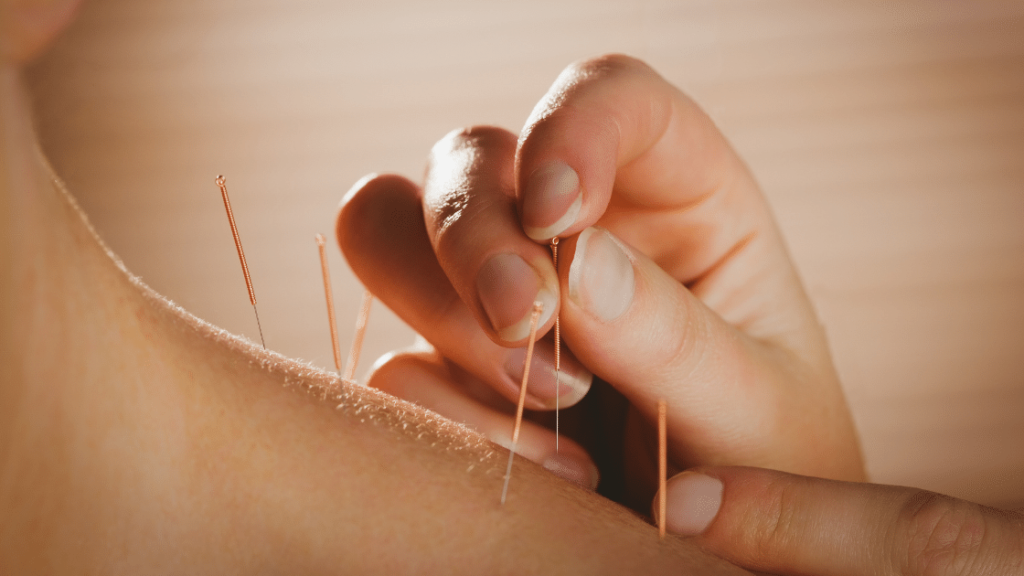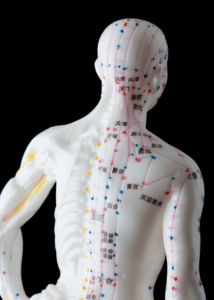Is Acupuncture Good for Pain?

If you’ve never tried it before, acupuncture may sound a little scary. I mean, the insertion of twenty or so tiny needles directly into your skin… I needn’t elaborate on why a newcomer to Traditional Chinese Medicine might be frightened.
But I assure you, it’s not as scary as it sounds. I, and the patients who regularly visit Brooke at our office, can attest to this. Just look at the evidence: the technique has been in practice for 2,500 years, and Brooke’s schedule is always full.
Ok! Now that you’re no longer scared of acupuncture, you’re curious about why so many people use it. While it’s sought out for just about any ailment you can think of, it’s most commonly used to treat pain. Muscular pain, joint pain, headaches, menstrual cramps, dental pain, and stomach aches are just a few types of pain it’s been shown to ease. But you still may be skeptical about its effectiveness. How can a bunch of needles, some of which aren’t even placed on the hurting body part, offer pain relief?
How Does Acupuncture Treat Pain?
See all those little dots on the mannequin’s body? Those are acupuncture points, also called acupoints. And see those lines traveling up and down the body? Those are meridians or energy pathways. Qi, pronounced “chee” and often spelled “chi”, is known as the vital life energy, and is believed to flow through these energy channels. This life force is of central importance in Traditional Chinese Medicine, and blockages in its flow are theorized to cause illness and pain.
Acupuncture for Pain
Each acupoint refers to a specific area of the body. Depending on the type of discomfort you experience, your acupuncturist will stimulate the point(s) correlated with the cause. A point is usually pierced with a light needle, but can also be addressed with manual pressure, heat, or electrical stimulation. When the acupoint is pressed, the qi blockage releases and the body’s natural healing process begins.
What are some examples of pain points treated by acupuncture?
A commonly treated acupoint is LI-4, also known as Hegu, for headache relief. The SP-6 acupoint, or San Yin Jiao, is located on the medial leg just above the ankle and is stimulated for dysmenorrhea relief. I’d list all the other types of pain and their correlated points, but most ailments are treated with multiple acupoints at a time; in fact, the aforementioned dysmenorrhea is treated with both Hegu and San Yin Jiao, in addition to a few others. As much as I love to write, I don’t have time to pen a 500-page novel titled, “All the Acupuncture Points in the Body, What They Treat, and How You Can Find This Information on Google Without Me Writing a Textbook”.
If you’re skeptical about qi, there are other explanations for why acupuncture relieves pain. There was once a patient at our office who referred to acupuncture as voodoo stuff, yet he received the treatment on a regular basis and swore it worked. He just wasn’t sure how, and neither are plenty who get it routinely. Another explanation for its ability to fight pain is that the pressure causes an endorphin rush. Endorphins, hormones produced and stored in the pituitary gland, activating the opioid receptors upon release. The sensation of the needle sends a message to the brain to release these pain-relieving chemicals. Do you, or does someone you know, have tattoos? Yeah, those things hurt, but your body naturally reacts to that needle by releasing endorphins to ease the pain and mind. That’s why some people describe the experience, however painful, as euphoric. Acupuncture needles, even if they produce little to no pain, activate that same response.
Can The Procedure Hurt?
In most cases, you will experience little to no pain when the needles are inserted. You may not even feel the needles when they enter your skin. They’re very delicate and as thin as a single hair.
However, you may have a tender spot or two that can cause a short burst of pain upon insertion. I have one on the inside of my foot, just below the medial malleolus. That thing hurts every single time, sending a burning sensation up my calf. But it lasts less than a second. I just brace myself for it, and everything that follows it is relaxing.
Is Acupuncture for Everybody?
While safe for most, acupuncture does come with contraindications. Consult your physician before scheduling a session if you have a pacemaker or other electrical devices, are on blood thinners, or if you have a bleeding disorder.
On the less serious side of things, acupuncture also isn’t for people who simply don’t like acupuncture. Just like with any type of bodywork, some patients report no significant relief from acupuncture. And that’s ok! Bodyworkers go into their professions knowing that their specialty isn’t for everyone. And I’m sure a person who sticks needles into people for a living knows this better than I do!
Now You Know!
Stay happy, healthy, and tell Brooke about your qi blockages!

Katrina Jenkins
Author, Licensed Massage Therapist
Katrina Jenkins graduated from Towson University in 2013 with a Bachelor’s Degree in Health Science and worked as a nurse’s aide briefly before pursuing her true passion. She graduated from the Massage Therapy Institute of Colorado in April 2016 with honors and completed the Touch of Healers Scholarship Program the following summer. She has been a part of the Moyer Total Wellness Team since the summer of 2017.
Resources
“Acupuncture: In Depth.” NCCIH, Jan. 2016, www.nccih.nih.gov/health/acupuncture-in-depth.
“Acupuncture Point Sensitivity Linked to Menstrual Pain.” Www.Healthcmi.com, www.healthcmi.com/Acupuncture-Continuing-Education-News/1414-acupuncture-point-sensitivity-linked-to-menstrual-pain. Accessed 29 Dec. 2020.
Flowers, James. “What Is Qi?” Evidence-Based Complementary and Alternative Medicine, vol. 3, no. 4, 2006, pp. 551–552, 10.1093/ecam/nel074. Accessed 6 Mar. 2019.
Harvard Health Publishing. “Relieving Pain with Acupuncture – Harvard Health.” Harvard Health, Harvard Health, 2019, www.health.harvard.edu/healthbeat/relieving-pain-with-acupuncture.
Photo Credit
Canva by Wavebreakmedia
and Canva by wnights

